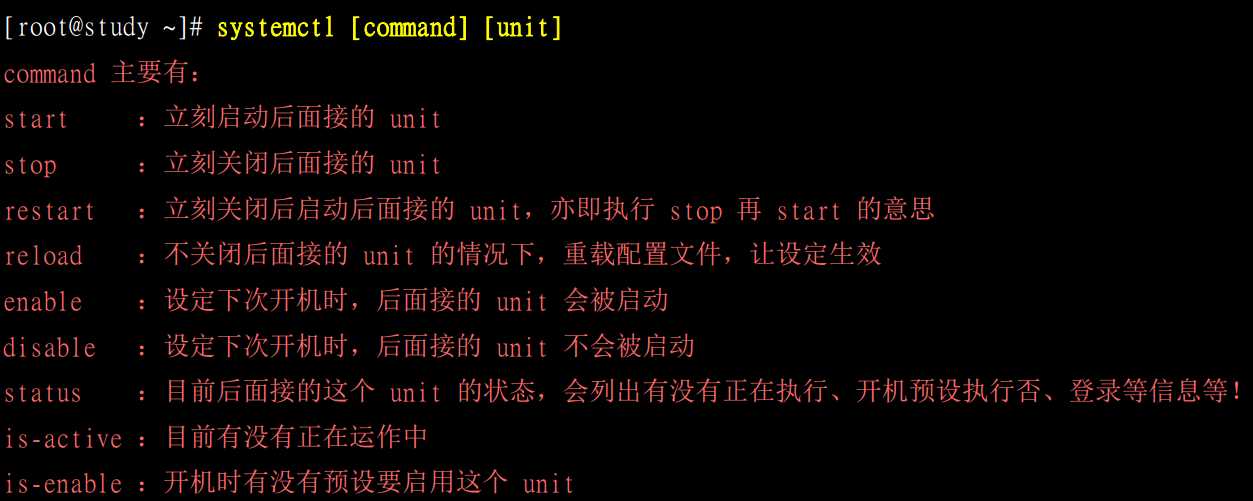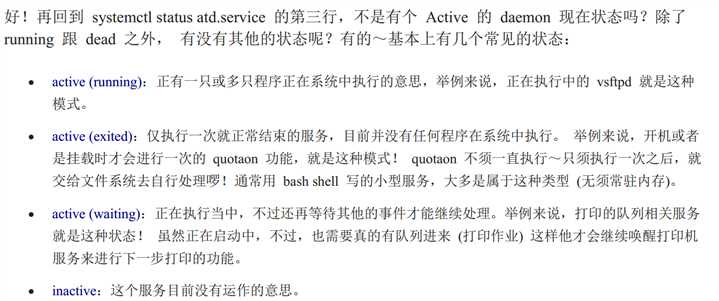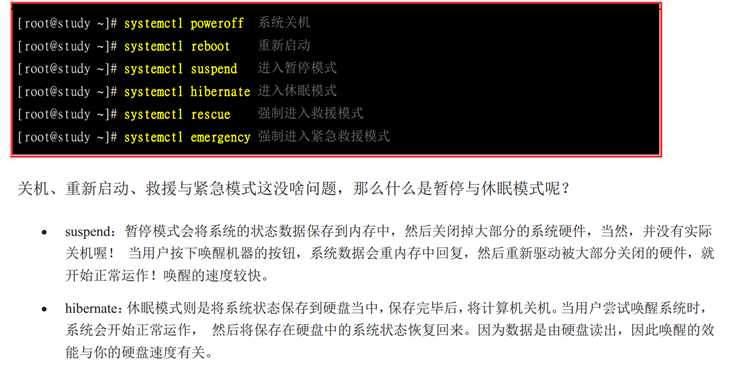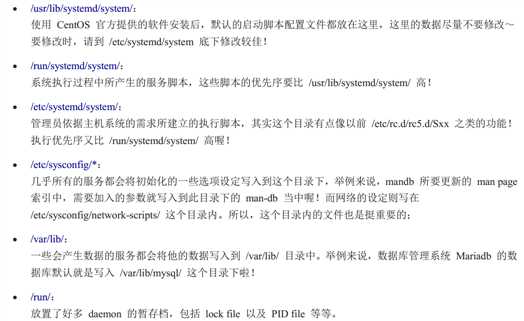systemctl

[root@localhost ~]# systemctl status atd.service #查询服务状态 ● atd.service - Job spooling tools Loaded: loaded (/usr/lib/systemd/system/atd.service; enabled; vendor preset: enabled) Active: active (running) since 一 2019-08-26 09:40:41 CST; 2 days ago #服务状态是running Main PID: 49782 (atd) Tasks: 1 CGroup: /system.slice/atd.service └─49782 /usr/sbin/atd -f 8月 26 09:40:41 localhost.localdomain systemd[1]: Started Job spooling tools. 8月 26 10:36:00 localhost.localdomain atd[53278]: Starting job 3 (a00003018e745c) for user ‘root‘ (0) 8月 26 10:54:42 localhost.localdomain atd[54730]: Starting job 4 (b00004018e7469) for user ‘root‘ (0) [root@localhost ~]# systemctl stop atd.service #关闭服务 [root@localhost ~]# systemctl status atd.service ● atd.service - Job spooling tools Loaded: loaded (/usr/lib/systemd/system/atd.service; enabled; vendor preset: enabled) Active: inactive (dead) since 三 2019-08-28 11:01:56 CST; 10s ago #服务状态为dead Process: 49782 ExecStart=/usr/sbin/atd -f $OPTS (code=exited, status=0/SUCCESS) Main PID: 49782 (code=exited, status=0/SUCCESS) 8月 26 09:40:41 localhost.localdomain systemd[1]: Started Job spooling tools. 8月 26 10:36:00 localhost.localdomain atd[53278]: Starting job 3 (a00003018e745c) for user ‘root‘ (0) 8月 26 10:54:42 localhost.localdomain atd[54730]: Starting job 4 (b00004018e7469) for user ‘root‘ (0) 8月 28 11:01:56 localhost.localdomain systemd[1]: Stopping Job spooling tools... 8月 28 11:01:56 localhost.localdomain systemd[1]: Stopped Job spooling tools. [root@localhost ~]# systemctl start atd.service [root@localhost ~]# systemctl status atd.service ● atd.service - Job spooling tools Loaded: loaded (/usr/lib/systemd/system/atd.service; enabled; vendor preset: enabled) Active: active (running) since 三 2019-08-28 11:02:26 CST; 8s ago Main PID: 92576 (atd) Tasks: 1 CGroup: /system.slice/atd.service └─92576 /usr/sbin/atd -f 8月 28 11:02:26 localhost.localdomain systemd[1]: Started Job spooling tools.






同时运行两个相同但不同端口的服务。该如何做?
鸟哥书中,用vsftpd来做例子。首先更改vsfptd的端口为555.这里我偷懒,前面的例子没有做。结果按照步骤来操作的时候,死活也弄不通,总是failed。。。。崩溃中,在看书,才发现,里面有一句,上一章我们将vsftpd的端口号改成555....好吧。。。去找前一章的相关例子
首先需要更改配置文件 /etc/vsftpd这个文件夹中 service服务在 /etc/systemd/system这个文件夹中
我们找到vsftpd.conf这个配置文件后,在后面加上了 listen_port=555这个端口号。但是我们restart提示,failed。。。。
[root@localhost ~]# systemctl restart vsftpd
Job for vsftpd.service failed because the control process exited with error code. See "systemctl status vsftpd.service" and "journalctl -xe" for details.
它让你查看 journalctl -xe这个命令来查看失败信息,如下(鸟哥文中,让你用/var/log/messages 来定位)
6985]: [system] Successfully activated service ‘org.fedoraproject.Setroubleshootd‘
ubleshoot[109349]: SELinux is preventing /usr/sbin/vsftpd from name_bind access on the
n[109349]: SELinux is preventing /usr/sbin/vsftpd from name_bind access on the tcp_sock
***** Plugin bind_ports (92.2 confidence) suggests ********************* #这就是建议,能解决的概率是92.2,肯定就是这个了
If you want to allow /usr/sbin/vsftpd to bind to network port 555
Then you need to modify the port type.
Do
# semanage port -a -t PORT_TYPE -p tcp 555 #这里截取的时候截取不全,就不弄了,就是列了很多type类型
where PORT_TYPE is one of the following: certmaster_port_t, cluster_por
***** Plugin catchall_boolean (7.83 confidence) suggests ***************
If you want to allow nis to enabled
Then you must tell SELinux about this by enabling the ‘nis_enabled‘ boolean
Do
setsebool -P nis_enabled 1
***** Plugin catchall (1.41 confidence) suggests ***********************
If you believe that vsftpd should be allowed name_bind access on the port 5
Then you should report this as a bug.
You can generate a local policy module to allow this access.
鸟哥的/messages定位
[root@localhost system]# grep sealert /var/log/messages #首先通过messages找到编号,就是后面那一堆1ce60b58-bcbf-498f-ad42-8512d83f0e61 Aug 28 15:09:32 localhost setroubleshoot: SELinux is preventing /usr/sbin/vsftpd from name_bind access on the tcp_socket port 555. For complete SELinux messages run: sealert -l 1ce60b58-bcbf-498f-ad42-8512d83f0e61 Aug 28 15:13:49 localhost setroubleshoot: SELinux is preventing /usr/sbin/vsftpd from name_bind access on the tcp_socket port 555. For complete SELinux messages run: sealert -l 1ce60b58-bcbf-498f-ad42-8512d83f0e61 Aug 28 15:19:49 localhost setroubleshoot: SELinux is preventing /usr/sbin/vsftpd from name_bind access on the tcp_socket port 555. For complete SELinux messages run: sealert -l 1ce60b58-bcbf-498f-ad42-8512d83f0e61 Aug 28 15:23:37 localhost setroubleshoot: SELinux is preventing /usr/sbin/vsftpd from name_bind access on the tcp_socket port 555. For complete SELinux messages run: sealert -l 1ce60b58-bcbf-498f-ad42-8512d83f0e61 Aug 28 15:25:02 localhost setroubleshoot: SELinux is preventing /usr/sbin/vsftpd from name_bind access on the tcp_socket port 555. For complete SELinux messages run: sealert -l 1ce60b58-bcbf-498f-ad42-8512d83f0e61 Aug 28 15:25:30 localhost setroubleshoot: SELinux is preventing /usr/sbin/vsftpd from name_bind access on the tcp_socket port 555. For complete SELinux messages run: sealert -l 1ce60b58-bcbf-498f-ad42-8512d83f0e61
[root@localhost system]# sealert -l 1ce60b58-bcbf-498f-ad42-8512d83f0e61 #然后通过这个编号,再来sealert -l一下,就能看到详细信息了,如下图。是不是跟刚才那个 journalctl -xe 的结果是类似的?不过这个中文,那个英文。 SELinux is preventing /usr/sbin/vsftpd from name_bind access on the tcp_socket port 555. ***** 插件 bind_ports (92.2 置信度) 建议 ****************************************** If you want to allow /usr/sbin/vsftpd to bind to network port 555 Then you need to modify the port type. Do # semanage port -a -t PORT_TYPE -p tcp 555 其中 PORT_TYPE 是以下之一:certmaster_port_t, cluster_port_t, ephemeral_port_t, ftp_data_port_t, ftp_port_t, hadoop_datanode_port_t, hplip_port_t, isns_port_t, port_t, postgrey_port_t, unreserved_port_t。#这里就是上一张图缺失的类型列表 ***** 插件 catchall_boolean (7.83 置信度) 建议 ************************************ If you want to allow nis to enabled Then 必须启用 ‘nis_enabled‘ 布尔值告知 SELinux 此情况。 Do setsebool -P nis_enabled 1 ***** 插件 catchall (1.41 置信度) 建议 ******************************************** If you believe that vsftpd should be allowed name_bind access on the port 555 tcp_socket by default. Then 应该将这个情况作为 bug 报告。 可以生成本地策略模块以允许此访问。 Do allow this access for now by executing: # ausearch -c ‘vsftpd‘ --raw | audit2allow -M my-vsftpd # semodule -i my-vsftpd.pp 更多信息: 源环境 (Context) system_u:system_r:ftpd_t:s0-s0:c0.c1023 目标环境 system_u:object_r:hi_reserved_port_t:s0 目标对象 port 555 [ tcp_socket ] 源 vsftpd 源路径 /usr/sbin/vsftpd 端口 555 主机 localhost.localdomain 源 RPM 软件包 目标 RPM 软件包 策略 RPM selinux-policy-3.13.1-229.el7.noarch Selinux 已启用 True 策略类型 targeted 强制模式 Enforcing 主机名 localhost.localdomain 平台 Linux localhost.localdomain 3.10.0-957.el7.x86_64 #1 SMP Thu Nov 8 23:39:32 UTC 2018 x86_64 x86_64 警报计数 6 第一个 2019-08-28 15:09:30 CST 最后一个 2019-08-28 15:25:26 CST 本地 ID 1ce60b58-bcbf-498f-ad42-8512d83f0e61 原始核查信息 type=AVC msg=audit(1566977126.934:14578): avc: denied { name_bind } for pid=109344 comm="vsftpd" src=555 scontext=system_u:system_r:ftpd_t:s0-s0:c0.c1023 tcontext=system_u:object_r:hi_reserved_port_t:s0 tclass=tcp_socket permissive=0 Hash: vsftpd,ftpd_t,hi_reserved_port_t,tcp_socket,name_bind
接着我们根据他的提示来修改就OK了
semanage port -a -t ftp_port_t -p tcp 555 然后在重启一下,netstat -tlnp一下就看到了
[root@localhost ~]# netstat -tlnp
Active Internet connections (only servers)
Proto Recv-Q Send-Q Local Address Foreign Address State PID/Program name
tcp 0 0 0.0.0.0:111 0.0.0.0:* LISTEN 1/systemd
tcp 0 0 0.0.0.0:6000 0.0.0.0:* LISTEN 8138/X
tcp 0 0 192.168.122.1:53 0.0.0.0:* LISTEN 8598/dnsmasq
tcp 0 0 0.0.0.0:22 0.0.0.0:* LISTEN 7675/sshd
tcp 0 0 127.0.0.1:631 0.0.0.0:* LISTEN 94257/cupsd
tcp 0 0 127.0.0.1:25 0.0.0.0:* LISTEN 8037/master
tcp6 0 0 :::555 :::* LISTEN 109849/vsftpd #这里,看到了么?端口已经改成了555
tcp6 0 0 :::111 :::* LISTEN 1/systemd
tcp6 0 0 :::6000 :::* LISTEN 8138/X
tcp6 0 0 :::22 :::* LISTEN 7675/sshd
tcp6 0 0 ::1:631 :::* LISTEN 94257/cupsd
tcp6 0 0 ::1:25 :::* LISTEN 8037/master
剩下的,就是两个端口同时运行的问题了。复制conf,复制service,然后重启,开机启动,就OK了
[root@localhost system]# cp vsftpd.conf vsftpd2.conf
然后vim ,在vsftpd中,将端口号,注释掉。就是使用默认端口。复制service
首先要进入目录,然后cp
[root@localhost system]# cd /etc/systemd/system
[root@localhost system]# cp /usr/lib/systemd/system/vsftpd.service vsftpd2.service
然后更改vsftpd2.servcie的配置,
[Unit]
Description=Vsftpd second ftp daemon #更改一下这个,描述改一下,便于识别
After=network.target
[Service]
Type=forking
ExecStart=/usr/sbin/vsftpd /etc/vsftpd/vsftpd.conf /etc/vsftpd/vsftpd2.conf #将2号配置文件写入到servcie中
[Install]
WantedBy=multi-user.target
到这里基本上具体的工作就完成了。剩下的就是重载,重启,开机启动,查看
[root@localhost system]# systemctl daemon-reload #重载
[root@localhost system]# systemctl list-unit-files --all | grep vsftpd #查看vsftpd的相关服务信息
vsftpd.service enabled
vsftpd2.service enabled #默认是disabled,这里是我重新copy的,已经enable,所以现实是enabled
vsftpd@.service disabled
vsftpd.target disabled
[root@localhost system]# systemctl status vsftpd2.service #查看服务2的状态
● vsftpd2.service - Vsftpd second ftp daemon
Loaded: loaded (/etc/systemd/system/vsftpd2.service; enabled; vendor preset: disabled)
Active: active (running) since 三 2019-08-28 15:34:24 CST; 42min ago
Main PID: 110076 (vsftpd)
CGroup: /system.slice/vsftpd2.service
└─110076 /usr/sbin/vsftpd /etc/vsftpd/vsftpd.conf /etc/vsftpd/vsftpd2.conf
8月 28 15:34:24 localhost.localdomain systemd[1]: Starting Vsftpd second ftp daemon...
8月 28 15:34:24 localhost.localdomain systemd[1]: Started Vsftpd second ftp daemon.
[root@localhost system]# systemctl restart vsftpd.service vsftpd2.service #重启服务
[root@localhost system]# systemctl enable vsftpd.service vsftpd2.servcie #设置开机启动,这里我字母写错了,看出来了么
Failed to execute operation: No such file or directory
[root@localhost system]# systemctl enable vsftpd.service vsftpd2.service#这是改完之后的,不认真真看不出来
[root@localhost system]# systemctl status vsftpd.service vsftpd2.service#查看状态
● vsftpd.service - Vsftpd ftp daemon
Loaded: loaded (/usr/lib/systemd/system/vsftpd.service; enabled; vendor preset: disabled)
Active: active (running) since 三 2019-08-28 16:17:14 CST; 35s ago
Main PID: 112853 (vsftpd)
CGroup: /system.slice/vsftpd.service
└─112853 /usr/sbin/vsftpd /etc/vsftpd/vsftpd.conf
8月 28 16:17:14 localhost.localdomain systemd[1]: Starting Vsftpd ftp daemon...
8月 28 16:17:14 localhost.localdomain systemd[1]: Started Vsftpd ftp daemon.
● vsftpd2.service - Vsftpd second ftp daemon
Loaded: loaded (/etc/systemd/system/vsftpd2.service; enabled; vendor preset: disabled)
Active: active (running) since 三 2019-08-28 16:17:14 CST; 35s ago
Main PID: 112856 (vsftpd)
CGroup: /system.slice/vsftpd2.service
└─112856 /usr/sbin/vsftpd /etc/vsftpd/vsftpd.conf /etc/vsftpd/vsftpd2.conf
8月 28 16:17:14 localhost.localdomain systemd[1]: Starting Vsftpd second ftp daemon...
8月 28 16:17:14 localhost.localdomain systemd[1]: Started Vsftpd second ftp daemon.
[root@localhost system]# netstat -ntlp #查看一下信息
Active Internet connections (only servers)
Proto Recv-Q Send-Q Local Address Foreign Address State PID/Program name
tcp 0 0 0.0.0.0:111 0.0.0.0:* LISTEN 1/systemd
tcp 0 0 0.0.0.0:6000 0.0.0.0:* LISTEN 8138/X
tcp 0 0 192.168.122.1:53 0.0.0.0:* LISTEN 8598/dnsmasq
tcp 0 0 0.0.0.0:22 0.0.0.0:* LISTEN 7675/sshd
tcp 0 0 127.0.0.1:631 0.0.0.0:* LISTEN 94257/cupsd
tcp 0 0 127.0.0.1:25 0.0.0.0:* LISTEN 8037/master
tcp6 0 0 :::555 :::* LISTEN 112856/vsftpd #555端口的vsftpd
tcp6 0 0 :::111 :::* LISTEN 1/systemd
tcp6 0 0 :::6000 :::* LISTEN 8138/X
tcp6 0 0 :::21 :::* LISTEN 112853/vsftpd #默认端口的vsftpd
tcp6 0 0 :::22 :::* LISTEN 7675/sshd
tcp6 0 0 ::1:631 :::* LISTEN 94257/cupsd
tcp6 0 0 ::1:25 :::* LISTEN 8037/master
多重的重复设定
就是要重复设置的指令,例如上例子中的,多端口的vsftp就是一个例子,还有书中提到的getty,多用户登录
从文中的意思就是,所有在/usr/lib/systemd/system文件夹中,带有@的服务,都可以直接用 systemctl start xxxxxx.service来启动
我们进入/usr/lib/systemd/system文件夹中,然后ls | grep @ 来查看所有带@符号的服务
[root@localhost system]# ls | grep @ anaconda-shell@.service anaconda-tmux@.service autovt@.service chrony-dnssrv@.service chrony-dnssrv@.timer clean-mount-point@.service configure-printer@.service container-getty@.service getty@.service #多用户的例子,就是书中的例子 lvm2-pvscan@.service mdadm-grow-continue@.service mdadm-last-resort@.service mdadm-last-resort@.timer mdmon@.service rdma-load-modules@.service rsyncd@.service saned@.service selinux-policy-migrate-local-changes@.service serial-getty@.service sshd@.service systemd-backlight@.service systemd-fsck@.service systemd-hibernate-resume@.service systemd-nspawn@.service systemd-rfkill@.service teamd@.service usb_modeswitch@.service vsftpd@.service #我们要用的例子 wacom-inputattach@.service [root@localhost system]#
上面的这些服务,都可以在更改配置文件后,直接起动。例如 vsftp。下面我们如果要开启 一个6666端口的vsftp服务该如何呢?
首先修改配置文件,然后直接start就可以,试试看
[root@localhost system]# cd /etc/vsftpd [root@localhost vsftpd]# ls ftpusers user_list vsftpd2.conf vsftpd.conf vsftpd_conf_migrate.sh [root@localhost vsftpd]# cp vsftpd.conf vsftpd3.conf #创建一个新的配置文件vsftpd3.conf [root@localhost vsftpd]# ls ftpusers user_list vsftpd2.conf vsftpd3.conf vsftpd.conf vsftpd_conf_migrate.sh [root@localhost vsftpd]# vim vsftpd3.conf #修改他,然后将端口更改为6666 # Example config file /etc/vsftpd/vsftpd.conf # # The default compiled in settings are fairly paranoid. This sample file # loosens things up a bit, to make the ftp daemon more usable. # Please see vsftpd.conf.5 for all compiled in defaults. # # READ THIS: This example file is NOT an exhaustive list of vsftpd options. # Please read the vsftpd.conf.5 manual page to get a full idea of vsftpd‘s # capabilities. # # Allow anonymous FTP? (Beware - allowed by default if you comment this out). anonymous_enable=YES # # Uncomment this to allow local users to log in. # When SELinux is enforcing check for SE bool ftp_home_dir local_enable=YES # # Uncomment this to enable any form of FTP write command. write_enable=YES # # Default umask for local users is 077. You may wish to change this to 022, # if your users expect that (022 is used by most other ftpd‘s) local_umask=022 # # Uncomment this to allow the anonymous FTP user to upload files. This only # has an effect if the above global write enable is activated. Also, you will # obviously need to create a directory writable by the FTP user. # When SELinux is enforcing check for SE bool allow_ftpd_anon_write, allow_ftpd_full_access #anon_upload_enable=YES # # Uncomment this if you want the anonymous FTP user to be able to create # new directories. #anon_mkdir_write_enable=YES # # Activate directory messages - messages given to remote users when they # go into a certain directory. dirmessage_enable=YES # # Activate logging of uploads/downloads. xferlog_enable=YES # # Make sure PORT transfer connections originate from port 20 (ftp-data). connect_from_port_20=YES # # If you want, you can arrange for uploaded anonymous files to be owned by # a different user. Note! Using "root" for uploaded files is not # recommended! #chown_uploads=YES #chown_username=whoever # # You may override where the log file goes if you like. The default is shown # below. #xferlog_file=/var/log/xferlog # # If you want, you can have your log file in standard ftpd xferlog format. # Note that the default log file location is /var/log/xferlog in this case. xferlog_std_format=YES # # You may change the default value for timing out an idle session. "vsftpd3.conf" 129L, 5133C 1,1 顶端 # however, may confuse older FTP clients. #async_abor_enable=YES # # By default the server will pretend to allow ASCII mode but in fact ignore # the request. Turn on the below options to have the server actually do ASCII # mangling on files when in ASCII mode. The vsftpd.conf(5) man page explains # the behaviour when these options are disabled. # Beware that on some FTP servers, ASCII support allows a denial of service # attack (DoS) via the command "SIZE /big/file" in ASCII mode. vsftpd # predicted this attack and has always been safe, reporting the size of the # raw file. # ASCII mangling is a horrible feature of the protocol. #ascii_upload_enable=YES #ascii_download_enable=YES # # You may fully customise the login banner string: #ftpd_banner=Welcome to blah FTP service. # # You may specify a file of disallowed anonymous e-mail addresses. Apparently # useful for combatting certain DoS attacks. #deny_email_enable=YES # (default follows) #banned_email_file=/etc/vsftpd/banned_emails # # You may specify an explicit list of local users to chroot() to their home # directory. If chroot_local_user is YES, then this list becomes a list of # users to NOT chroot(). # (Warning! chroot‘ing can be very dangerous. If using chroot, make sure that # the user does not have write access to the top level directory within the # chroot) #chroot_local_user=YES #chroot_list_enable=YES # (default follows) #chroot_list_file=/etc/vsftpd/chroot_list # # You may activate the "-R" option to the builtin ls. This is disabled by # default to avoid remote users being able to cause excessive I/O on large # sites. However, some broken FTP clients such as "ncftp" and "mirror" assume # the presence of the "-R" option, so there is a strong case for enabling it. #ls_recurse_enable=YES # # When "listen" directive is enabled, vsftpd runs in standalone mode and # listens on IPv4 sockets. This directive cannot be used in conjunction # with the listen_ipv6 directive. listen=NO # # This directive enables listening on IPv6 sockets. By default, listening # on the IPv6 "any" address (::) will accept connections from both IPv6 # and IPv4 clients. It is not necessary to listen on *both* IPv4 and IPv6 # sockets. If you want that (perhaps because you want to listen on specific # addresses) then you must run two copies of vsftpd with two configuration # files. # Make sure, that one of the listen options is commented !! listen_ipv6=YES pam_service_name=vsftpd userlist_enable=YES tcp_wrappers=YES listen_port=6666 #更改端口为6666 "vsftpd3.conf" 129L, 5133C 已写入 [root@localhost vsftpd]# systemctl start vsftp@vsftp3.service Failed to start vsftp@vsftp3.service: Unit not found. [root@localhost vsftpd]# systemctl start vsftp@vsftpd3.service Failed to start vsftp@vsftpd3.service: Unit not found. [root@localhost vsftpd]# systemctl start vsftpd@vsftpd3.service #我们重启服务,前面的vsftpd就是我们在前面/usr/lib/systemd/system中的带@的服务。后面的vsftpd3就是你改的配置文件的名字对应的服务 [root@localhost vsftpd]# netstat -tlnp Active Internet connections (only servers) Proto Recv-Q Send-Q Local Address Foreign Address State PID/Program name tcp 0 0 0.0.0.0:111 0.0.0.0:* LISTEN 1/systemd tcp 0 0 0.0.0.0:6000 0.0.0.0:* LISTEN 8138/X tcp 0 0 192.168.122.1:53 0.0.0.0:* LISTEN 8598/dnsmasq tcp 0 0 0.0.0.0:22 0.0.0.0:* LISTEN 7675/sshd tcp 0 0 127.0.0.1:631 0.0.0.0:* LISTEN 94257/cupsd tcp 0 0 127.0.0.1:25 0.0.0.0:* LISTEN 8037/master tcp6 0 0 :::6666 :::* LISTEN 116405/vsftpd #看到了么?直接就OK了。。。。是不是很简单,是不是比刚才那么改简单?但是要这样做的根本就是要有对应的@服务才行,否则你还是要。。。。。 tcp6 0 0 :::555 :::* LISTEN 112856/vsftpd tcp6 0 0 :::111 :::* LISTEN 1/systemd tcp6 0 0 :::6000 :::* LISTEN 8138/X tcp6 0 0 :::21 :::* LISTEN 112853/vsftpd tcp6 0 0 :::22 :::* LISTEN 7675/sshd tcp6 0 0 ::1:631 :::* LISTEN 94257/cupsd tcp6 0 0 ::1:25 :::* LISTEN 8037/master
重点来了。做我们自己的服务,有意思喽。我喜欢这玩意。书中做一个自动备份系统的服务,我们来敲一遍
原文:https://www.cnblogs.com/Lonelychampion/p/11425297.html